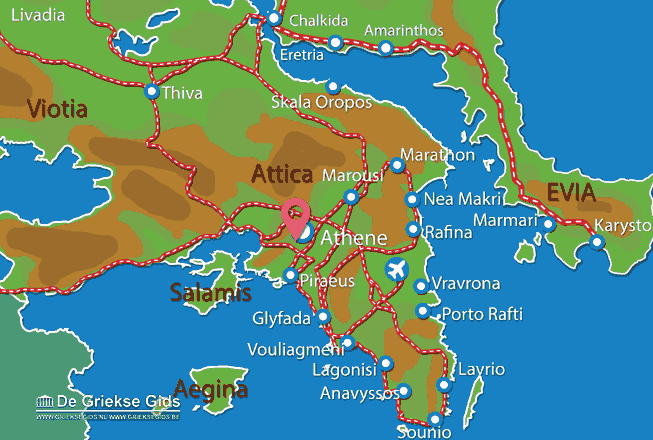Plaka Athens - Attica (Greece)
Plaka. Plaka, also known as the “neighborhood of the gods,” is the oldest neighbourhood of Athens. Walking on its paved narrow streets you get the feeling that you are travelling back in time. The origin of the name of the neighborhood is unknown, although theories abound. According to popular belief, Plaka was named after a slab of stone that was found near the church of Ayios Georgios Alexandrias, in the vicinity of the theater of Dionysos. The beautiful neoclassical style color of the houses, the architecture, the well-kept gardens, and the beauty and atmosphere of the neighborhood are enchanting. In Plaka, the air you breathe is different; it is lighter, cleaner, and fragrant, like a gift of the gods. When you visit Plaka you should bring a map, because you might get lost in the labyrinth of narrow streets and alleys. In Adrianou Street, the central street of the neighbourhood, as in other streets in the area, you will find shops selling traditional products, souvenirs, Greek folk art and handicrafts, etc.
Photo Gallery Plaka Athens - Photos of Plaka Athens
The sights of Plaka
Anafiotika
The foothills of the Acropolis have the charm of a beautiful island village. It was built in the mid 19th century by the renowned builders of the Aegean island of Anafi, who were invited to construct the palace of the first king of the Hellenes, Otto (see page 47). Feeling nostalgic for their birthplace in their long stay in Athens they recreated it in the upper area of Plaka. They built small, whitewashed houses, reproducing the architectural style of their village. We recommend that you visit Anafiotika, the neighborhood of the Anafiotes, a unique, charming area.
Filomousou Etaireias Square
The central square of the neighborhood was named after the Filomousos Etairia (The Society of the Friends of the Muses, in other words, the nine goddesses of the Arts), which was founded in 1813. The purpose of the Society was the promotion of Greek studies and the preservation of the archaeological treasures of Athens. At the square, located at the crossroads of Kydathinaion Str, Farmaki Str, Olympiou Dios Str and Angelou Geronda Str, are a multitude of cafes, restaurants, clubs with live music and souvenir shops.
The Children’s Museum
Located at Kydathinaion Str is a wonderful place for children. In the attic is a reconstructed room with old furniture, a radio, and theater in the style of old Athenian homes, named “granddad and grandma’s room,” where children may play and dress in old style clothes. The Museum houses among others, an exhibition of paintings by children, old toys, a fairground and a library. If you have children, be sure to visit the Children’s Museum. It’s, also, worth seeing the neighboring Museum of Greek Children’s Art (9, Kodrou Str.) a pioneering Museum, because it's one of the very few worldwide that exclusively exhibits drawings and three dimensional artworks created by children 5 to 14 years old. Created in 1994, it aims to highlight the uniqueness of children’s art, to contribute to the development of a young generation interested in culture, to propose an educational approach enriched by art created by children and to collaborate with relevant institutions in Greece and abroad.
Lysikrates Monument
In ancient Athens, theatrical performances held at the theater of Dionysos were funded by wealthy citizens, the donors. The city gave a prize to the donor of the winning performance. When the wealthy Lysikrates won the prize in 334 BC, he constructed a monument to house it. The monument is preserved (ancient Tripodon Str. - pavement of the road is preserved in a special space in a renovated building at number 28). The monument has had a long and varied history. In 1658, a Capuchin monastery was founded here. In 1669, Capuchins bought the monument. Lord Byron stayed at the monastery in his second visit to Greece. In the gardens, the cultivation of the tomato, hitherto unknown in Greece, was introduced.
The Museum of the University of Athens
The building housing the museum, located at Tholou Str., was formerly the residence of the architect Kleanthis (1832-1833). Subsequently, it housed the first University of Athens (1837-1842).
The Kanellopoulos Museum
was founded in 1976 following the donation of the private collection of Pavlos and Alexandra Kanellopoulos to the Greek state. It is housed in the neoclassical mansion of the Mihalea family. The Kanellopoulos collection consists of archaeological finds and works of art from the prehistoric era to modern times.
Text: Greek National Tourism Organisation
Text: Jorgos and Wendy Nikolidakis - Text edited by Katrina Butzer
Weather forecast Plaka Athens (Attica)
Plaka Athens in other languages
 Plaka (GriekseGids.nl)
Plaka (GriekseGids.nl)
 Plaka (GriekseGids.be)
Plaka (GriekseGids.be)
 Plaka Athens (GreeceGuide.co.uk)
Plaka Athens (GreeceGuide.co.uk)
 Plaka Athens (GriechenlandWeb.de)
Plaka Athens (GriechenlandWeb.de)
Attica: Where on the map is Plaka Athens located?















